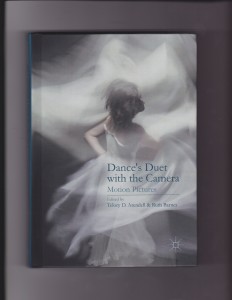 I am happy to announce the publication of Dance’s Duet with the Camera. This collection of essays, edited by Telory D. Arendell and Ruth Barnes and published by Palgrave Macmillan, “takes on the difficult task of verbalizing how the live aspects of present, sweaty, energy-driven dancers might collaborate with the more staid, focused, and digitally manipulated forms of either 2D or 3D film.”
I am happy to announce the publication of Dance’s Duet with the Camera. This collection of essays, edited by Telory D. Arendell and Ruth Barnes and published by Palgrave Macmillan, “takes on the difficult task of verbalizing how the live aspects of present, sweaty, energy-driven dancers might collaborate with the more staid, focused, and digitally manipulated forms of either 2D or 3D film.”
My own contribution to the book is a chapter on Fred Astaire. This marvelous dancer’s best work was captured on film. Moreover, Astaire exercised considerable control over how his work was recorded. My study tracked the development of his inimitable style across the two decades of his Hollywood career, through a movement analysis of solos drawn from three films, one from early in his career, one mid-career, and his final staring role in a musical.
Dance’s Duet with the Camera began with a call for papers early in 2011. It took five years and enormous perseverance on the part of the two editors to bring the book into being. This was not due to any lack of commitment on the part of the contributors. Rather the arduous journey of this publication from conception to reality reflects the difficulty of publishing books about dance.
Walk into any brick and mortar bookstore today and see how much shelf space is devoted to dance and/or movement books. This will provide a pretty clear picture of the challenges that Arendell and Barnes faced.
Consequently, the publication of Dance’s Duet with the Camera is a great triumph. It’s multiple and varied essays are written from the dancer’s perspective in five parts addressing “Site/Sight and the Body,” “Movement Beyond the I/Eye,” “Querying Praxis,” “Bodies, Spaces, Camera,” and “New Technologies: Dance as 3D’s Ultimate Agent.”
